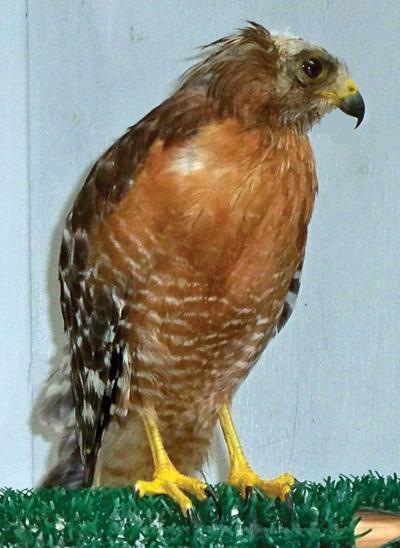To the injured party, it must have seemed like a scene right out
of Hitchcock’s movie,
”
The Birds
”
. Only in this case it was a bird-on-bird crime.
To the injured party, it must have seemed like a scene right out of Hitchcock’s movie, “The Birds”. Only in this case it was a bird-on-bird crime.
The victim was an adult red-shouldered hawk attacked near Chesbro Reservoir in Morgan Hill in April by a mob of birds – likely crows – that felt threatened by the bird-of-prey. It is common behavior, especially during springtime baby-season, for smaller birds to mob predators (such as hawks, owls and eagles, as well as mammals, i.e. cats that climb trees to reach a nest) that are perceived as a danger.
Mobbing typically occurs while the raptors are in flight and usually consists of non-lethal pecking and diving to drive away the enemy. Because there were no witnesses to this assault (it’s even possible that the hawk was sitting on its own nest in a tree), it will never be known just why this hawk plunged to the ground, lying bleeding and near death until Santa Clara County Animal Control and Care officers sped to the rescue and brought it to the Wildlife Education and Rehabilitation Center.
The hawk’s initial examination at WERC revealed that the top of its head was completely missing the feathers, with only bare skin visible, and with multiple bleeding wounds. The hawk was extremely weak, uncoordinated and unable to stand – all of which indicated grievous brain trauma. There was bruising and bleeding over its eye, causing concern about possible eye injuries.
After emergency treatment at WERC, the hawk was brought to Dr. Jaspal Harita of Morgan Hill Animal Hospital, who examined it and prescribed an intense regimen of pain medications, antibiotics, eye ointments and daily application of honey on its head wounds. Because of its antibacterial properties, honey has been used for thousands of years to promote the healing of wounds.
Since the hawk was so traumatized and weak, he had to be hand-fed for a month, as he could not eat the small rodents on his own. It took more than two weeks before he was even able to stand and perch consistently on both feet. After one month of daily treatments and TLC, the hawk’s wounds had almost healed – he now had a halo of head feathers – and his vision improved well enough that he was transferred from the clinic to an outside enclosure that allowed him to fly around while still recuperating with continued medical care.
After three months, he had completely healed and was able to move on into the 100-foot flight aviary, where he is kept company by two orphaned red-shouldered hawks and an injured juvenile red-tailed hawk, in order to build up his muscles and prepare him for his release. All he is waiting for now is to grow out new tail feathers to replace the ones that are frayed from the original trauma and stress. Good tail feathers are important to the survival of a wild hawk, helping the hawk to “steer” and accurately seize prey such as field rodents and reptiles.
Come autumn, the hawk will be soaring gracefully up into the wild blue yonder. We wish him a long, healthy, high-flying life free from flocks of feathered mobsters.










